History
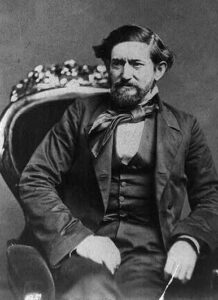
 William Alexander Anderson Wallace was born in Lexington, Virginia on April 3, 1817, parents of Scots-Irish descent. He might have stayed in Virginia, but in 1836, when he was just 19 years old, Wallace received news that one of his brothers had been killed in the Battle of Goliad, which was an early confrontation in the Texan war of independence with Mexico. Wallace promised to “take pay of the Mexicans” for his brother’s death. So, with revenge on his mind, Wallace left Lexington and headed for Texas. Upon his arrival, Wallace found that the war was already over. With no further need of his anger-revenge agenda, Wallace found he liked the spirited independence of the new Republic of Texas and decided to stay.
William Alexander Anderson Wallace was born in Lexington, Virginia on April 3, 1817, parents of Scots-Irish descent. He might have stayed in Virginia, but in 1836, when he was just 19 years old, Wallace received news that one of his brothers had been killed in the Battle of Goliad, which was an early confrontation in the Texan war of independence with Mexico. Wallace promised to “take pay of the Mexicans” for his brother’s death. So, with revenge on his mind, Wallace left Lexington and headed for Texas. Upon his arrival, Wallace found that the war was already over. With no further need of his anger-revenge agenda, Wallace found he liked the spirited independence of the new Republic of Texas and decided to stay.
Wallace was a big man, standing over six feet tall and weighing around 240 pounds. His size alone made him an intimidating figure, but his nickname of “Big Foot” came from his unusually large feet. Wallace didn’t think he would ever get the chance to fight Mexicans, but in 1842, he finally got his chance when he joined with other Texans to stop an invasion by the Mexican General Adrian Woll. During another skirmish with Mexicans, Wallace was captured, and he spent the next two years serving hard time in the notoriously brutal Perote Prison in Vera Cruz. He was finally released in 1844.
After his time as a prisoner of war, Wallace returned to Texas and found himself feeling tired of the rigidness of the formal Texan military force. So, he decided to leave the military for the less rigid organization of the Texas Rangers. The Texas Ranger program was part law-enforcement officers and part soldiers. They fought both bandits and Native Americans in the large, but sparsely populated reaches of the Texan frontier. “Big Foot” Williams served under the famous Ranger John Coffee Hays until the start of the Civil War in 1861. Williams was against the idea of Texas secession from the Union, but he was unwilling to fight against his own people. He had really assimilated himself into Texas…it was a big part of him. Williams spent most of the Civil War defending Texas against Native American attacks along the frontier. He didn’t get involved in the “politics” of the matter, he just knew that he was now a Texan, and he had to defend her at all costs.
Wallace spent many years in the wilds of Texas, having hundreds of adventures. He was attacked by Native Americans while working as a stage driver on the dangerous San Antonio-El Paso route. In that event, he 
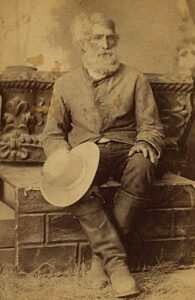 barely escaped with his life. The Natives stole his mules and left him stranded in the Texas desert. Forced to walk all the way to El Paso, he later said that he ate 27 eggs at the first house he came to after his long walk. Then, he went into town to have a “real meal.”
barely escaped with his life. The Natives stole his mules and left him stranded in the Texas desert. Forced to walk all the way to El Paso, he later said that he ate 27 eggs at the first house he came to after his long walk. Then, he went into town to have a “real meal.”
After many years and many adventures and in his old age, Wallace decided he had enough of life as a fighter and adventurer. He was tired and ready to learn how to relax. The state of Texas, in exchange for his years of service, granted Wallace land along the Medina River and in Frio County in the southern part of the state. Wallace loved to tell anyone who would listen, with highly embellished tales of his frontier days. Soon he became a well-known folk hero to the people of Texas. Wallace died on January 7, 1899. He is buried in the Texas State Cemetery.
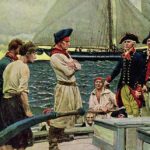
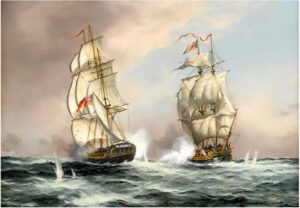 During the Revolutionary War, the United States, being a small start-up nation did not have huge amounts of funds to build a strong navy to fight against the influx of British ships sent to try to force our nation back under the rule of Great Britain, so being the resourceful nation they were, the Continental Congress made the decision to give privateers permission to attack any and all British ships on April 3, 1776. The bill was signed by John Hancock, president of the Continental Congress at that time. The bill issued “INSTRUCTIONS to the COMMANDERS of Private Ships or vessels of War, which shall have Commissions of Letters of Marque and Reprisal, authorizing them to make Captures of British Vessels and Cargoes.”
During the Revolutionary War, the United States, being a small start-up nation did not have huge amounts of funds to build a strong navy to fight against the influx of British ships sent to try to force our nation back under the rule of Great Britain, so being the resourceful nation they were, the Continental Congress made the decision to give privateers permission to attack any and all British ships on April 3, 1776. The bill was signed by John Hancock, president of the Continental Congress at that time. The bill issued “INSTRUCTIONS to the COMMANDERS of Private Ships or vessels of War, which shall have Commissions of Letters of Marque and Reprisal, authorizing them to make Captures of British Vessels and Cargoes.”
The private commercial ships were given “Letters of Marque and Reprisal” which were the official documents by which 18th-century governments commissioned private commercial ships, known as privateers, to act on their behalf. With these documents, they were officially allowed to start attacking ships carrying the flags of enemy nations. The motivation for the “assignments” was that any goods captured by the privateer were to be divided between the ship’s owner and the government that had issued the letter. It was a pretty good deal for the privateer, because they could then sell or use the good, or sell them for a profit. It was also a good deal for the government, because the received half of the “spoils” and they didn’t have to pay the privateer. As for the British ships…well, the deal was not so good.
The orders given to the privateers by Congress were “YOU may, by Force of Arms, attack, subdue, and take all Ships and other Vessels belonging to the Inhabitants of Great Britain, on the high seas, or between high-water and low-water Marks, except Ships and Vessels bringing Persons who intend to settle and reside in the United Colonies, or bringing Arms, Ammunition or Warlike Stores to the said Colonies, for the Use of such Inhabitants thereof as are Friends to the American Cause, which you shall suffer to pass unmolested, the Commanders thereof permitting a peaceable Search, and giving satisfactory Information of the Contents of the Ladings, and Destinations of the Voyages.”
The reality was that whether they were called privateers or pirates, the real distinction between the two was non-existent, at least to those who faced them on the high seas. The men were given the right to behave just 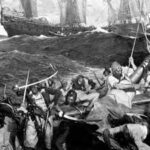
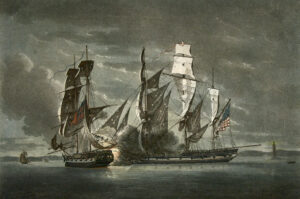 like pirates, so they behaved just like pirates, boarding and capturing ships and using force if necessary. The good news for the privateers was that privateers holding Letters of Marque were not subject to prosecution by their home nation and, if captured, were treated as prisoners of war instead of criminals by foreign nations. Even if they were caught, this was the best-case scenario for the privateers, and they were the best thing for this country at that important time in our history.
like pirates, so they behaved just like pirates, boarding and capturing ships and using force if necessary. The good news for the privateers was that privateers holding Letters of Marque were not subject to prosecution by their home nation and, if captured, were treated as prisoners of war instead of criminals by foreign nations. Even if they were caught, this was the best-case scenario for the privateers, and they were the best thing for this country at that important time in our history.
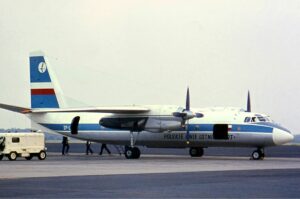
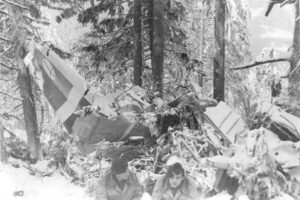 LOT Polish Airlines Flight 165 was a doomed Antonov AN-24 aircraft, registration SP-LTF. The plane operated as a scheduled passenger flight from Warsaw to Krakow Balice airport. Normally the 153-mile flight is a simple short hop, but on April 2, 1969, at 4:08pm local time the flight crashed into a mountain during a snowstorm. All 53 people on board were killed.
LOT Polish Airlines Flight 165 was a doomed Antonov AN-24 aircraft, registration SP-LTF. The plane operated as a scheduled passenger flight from Warsaw to Krakow Balice airport. Normally the 153-mile flight is a simple short hop, but on April 2, 1969, at 4:08pm local time the flight crashed into a mountain during a snowstorm. All 53 people on board were killed.
In 1969, crash investigation was not what it is today, and so a lot of the known information about the accident actually comes from two newspaper articles that were published in 1994. Of course, that doesn’t mean that no investigation took place, but from the sound of things, the documentation there has been kept classified according to the author who wrote that, “even 25 years after the accident, most documentation on the crash remains classified.” The information the author was able to gather came from the accounts of participants in the rescue action and some members of the accident investigation commission, but they asked for anonymity.
What is known and documented about the accident is that the aircraft took off from Warsaw at 3:20pm local time for a 55-minute flight to Krakow’s Balice Airport. The captain was Czeslaw Dolinski. The first officer received instructions at 3:49pm, to descend to 4,900 feet and to contact Balice control tower after passing Jedrzejów, which was less than 50 miles north of Krakow. At the time of the instructions, a military radar registered the aircraft at 13,000 feet. The pilots informed controllers in Okecie and Balice when the plane had passed the Jedrzejów VOR but there was some confusion when they provided three different passage times a few minutes apart. Shortly thereafter and before 4:00pm, the captain, who had taken over control at that point, called Balice. Dolinski gave his altitude as 12,100 feet, received the local weather report, and then was instructed to descend to 3,900 feet.
At 4:01pm, the aircraft was recorded at 7,900 feet and descending. Several radio exchanges took place between the place and the Balice radar operator over the next eight minutes, with the captain repeatedly asking for his fix and reporting problems with the beacon signal, and the operator asking for the aircraft’s position and altitude to help him find the aircraft on the radar screen. It was as if both the captain and the radar operator were confused as to where the plane was and at what altitude. At 4:05pm, the aircraft was noted near Maków Podhalanski, some 31 miles past Krakow…and at an altitude of 3,900 feet. The last transmission received from the airplane was, “Left turn to further…-” at 4:08.17pm. Seconds after that, radio contact was lost. It was at that moment that the plane crashed on the northern slope of Polica mountain, near Zawoja, southern Poland. the plane was located on the mountain side at an altitude of 3,900 feet.
The official death toll of 53 is still in question. The LOT Flight 165 manifest included 53 passengers and 5 crew members, but two days after the crash Polish press agencies published, 46 surnames, some without an address or name. According to the records, the passengers were 49 Poles, 3 Americans, and a Briton. The official 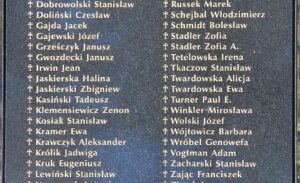
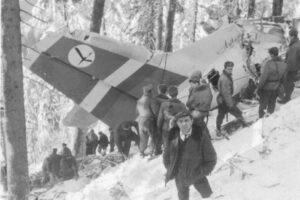 accident report, published in 1970, blamed the accident on the captain becoming lost. No one knew why the captain, just before the crash, was flying at low altitude some 31 miles past its intended destination. I don’t suppose it will ever be known for sure, or if it is, the fact that the documentation is classified will keep the truth from everyone anyway.
accident report, published in 1970, blamed the accident on the captain becoming lost. No one knew why the captain, just before the crash, was flying at low altitude some 31 miles past its intended destination. I don’t suppose it will ever be known for sure, or if it is, the fact that the documentation is classified will keep the truth from everyone anyway.

 Whether you or I prank anyone on this day makes no difference. This is the day for it. Why would anyone think that we need a day to be set aside whereby it was perfectly “legal” to play multiple tricks on people? Maybe they thought that after a long dreary winter, we needed a day to just get silly. Sounds good to me. I love a good prank as much as the next guy. I can’t say that I have always been good at pranking, and I can’t say some pranks haven’t blown up in my face…apparently not everyone likes to be pranked. Go figure!! I think for me is stems from my childhood years when my sisters and I tried to pull every April Fools’ Day joke we could think of on friends or family who happened to cross our paths.
Whether you or I prank anyone on this day makes no difference. This is the day for it. Why would anyone think that we need a day to be set aside whereby it was perfectly “legal” to play multiple tricks on people? Maybe they thought that after a long dreary winter, we needed a day to just get silly. Sounds good to me. I love a good prank as much as the next guy. I can’t say that I have always been good at pranking, and I can’t say some pranks haven’t blown up in my face…apparently not everyone likes to be pranked. Go figure!! I think for me is stems from my childhood years when my sisters and I tried to pull every April Fools’ Day joke we could think of on friends or family who happened to cross our paths.
While many possible origins for the national prank day exist, no one truly seems to know where or when it started. Maybe the origins story is a joke in its own right. It could be that whenever and wherever it got started, the initiator decided to say that the tradition started somewhere else so that they could say that they were just following the tradition they had heard about. That idea isn’t so farfetched, now, is it? Somebody, somewhere had to get this started. Still, maybe for those who don’t like being pranked, the originator didn’t want to take the blame. That makes sense to me too. If you have ever been “that guy” who pranked someone with no sense of humor, you know that you would gladly blame someone else…anyone else for making you do such a thing.
I’m just thankful that it was a tradition in our family…from our parents, Al and Collene Spencer, all the way down to my sisters, Cheryl Masterson, Caryl Reed, Alena Stevens, and Allyn Hadlock…and then on to the 
 generations beyond. People really should be taught at a young age to take a joke, and even to laugh at ourselves when we’ve been had. It’s a well-known fact, even from the Bible…Proverbs 17:22, “Laughter is like taking good medicine.” It is true, and even medicine has agreed that laughter is good for you. Laughter reduces stress, strengthens the immune system, boosts mood, and diminishes pain…just to name a few good things about laughter. So, for all you people who have no sense of humor…lighten up and laugh a little. You know you want to!! Happy April Fools’ Day everyone!!
generations beyond. People really should be taught at a young age to take a joke, and even to laugh at ourselves when we’ve been had. It’s a well-known fact, even from the Bible…Proverbs 17:22, “Laughter is like taking good medicine.” It is true, and even medicine has agreed that laughter is good for you. Laughter reduces stress, strengthens the immune system, boosts mood, and diminishes pain…just to name a few good things about laughter. So, for all you people who have no sense of humor…lighten up and laugh a little. You know you want to!! Happy April Fools’ Day everyone!!
 In a long-standing Western European tradition, the bees must be told of important events in the lives of their owners. Things such as deaths, births, marriages, and departures and returns in the keeper’s household. It is believed that the bees need to go through a mourning process to keep them emotionally healthy. If this practice was omitted or forgotten, and the bees were not “put into mourning,” then it was believed a penalty would be paid, such as the bees leaving their hive, stopping the production of honey, or even dying. Such a thing seems strange to anyone who has never had anything to do with bees, but who knows. Maybe they know, just like a dog or a cat knows their owner is gone. Best known in England, the practice has also been recorded in Ireland, Wales, Germany, Netherlands, France, Switzerland, Bohemia (now Czechia) and the United States.
In a long-standing Western European tradition, the bees must be told of important events in the lives of their owners. Things such as deaths, births, marriages, and departures and returns in the keeper’s household. It is believed that the bees need to go through a mourning process to keep them emotionally healthy. If this practice was omitted or forgotten, and the bees were not “put into mourning,” then it was believed a penalty would be paid, such as the bees leaving their hive, stopping the production of honey, or even dying. Such a thing seems strange to anyone who has never had anything to do with bees, but who knows. Maybe they know, just like a dog or a cat knows their owner is gone. Best known in England, the practice has also been recorded in Ireland, Wales, Germany, Netherlands, France, Switzerland, Bohemia (now Czechia) and the United States.
It is unknown how this practice got started, or where it stared exactly, but unfounded speculation has it that it 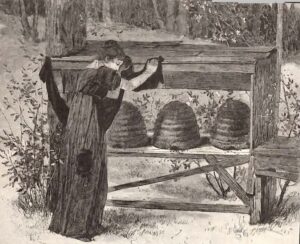 is loosely derived from or perhaps inspired by ancient Aegean notions about bees’ ability to bridge the natural world and the afterlife. There were many notions that people of ancient times believed, so I suppose this could be one of them.
is loosely derived from or perhaps inspired by ancient Aegean notions about bees’ ability to bridge the natural world and the afterlife. There were many notions that people of ancient times believed, so I suppose this could be one of them.
The whole practice has a number of strange parts to it and probably came from superstition. Apparently, it is tradition to give a piece of wedding cake or a funeral biscuit to the bees at wedding and funerals. This is done to inform the bees at the same time of the name of the party married or dead. Apparently, if the bees do not know about the marriage, they become very irate, and sting everybody within their reach. If they are ignorant of the death, they become sick, and many of them die. That might possibly speak to something similar to a pet losing its master. In the case of a death, it would inform them of a new owner. Again, this reminds me of a pet mourning an owner, even when they are shown love by the new owner. Animals can show love, maybe bees can too.

The practice even extends to the royal family. After the passing of Britain’s Queen Elizabeth II in 2022, the Royal Beekeeper, John Chapple, went out to inform the bees of Buckingham Palace and Clarence House of her passing and the accession of King Charles III. There is a proper process for informing the bees. According to Chapple, “You knock on each hive and say, “The mistress is dead, but don’t you go. Your master will be a good master to you.” Often the hive is also given a black sash for mourning. The purpose of all this is to ensure the health of the bees and the continuation of their honey production. It’s a strange, but interesting tradition.
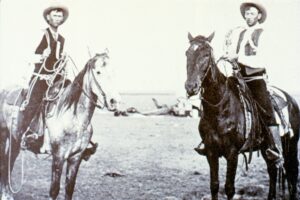 As the ranchers opened up the American West, they became some of America’s elite citizens. Their ranches soon became the target of criminals looking to make easy money. Of course, the ranchers had more than just their reputations…they had money and influence, and when their cattle started going missing, they were going to have their revenge. Cattle rustling was considered a serious offense in the American West and, in some cases, resulted in vigilantes hanging or shooting the thieves. Tempers always ran hot when these criminals were caught. While the ranchers were rich, they still worked just as hard for their money as anyone else.
As the ranchers opened up the American West, they became some of America’s elite citizens. Their ranches soon became the target of criminals looking to make easy money. Of course, the ranchers had more than just their reputations…they had money and influence, and when their cattle started going missing, they were going to have their revenge. Cattle rustling was considered a serious offense in the American West and, in some cases, resulted in vigilantes hanging or shooting the thieves. Tempers always ran hot when these criminals were caught. While the ranchers were rich, they still worked just as hard for their money as anyone else.
During the Civil War, Mexican cattle rustlers were a major issue. As with crimes across our southern border today, the Mexican government was accused of supporting the habit of cattle rustling. Of course, Mexican rustlers weren’t alone in their crimes. American rustlers also stole Mexican cattle from across the border, and 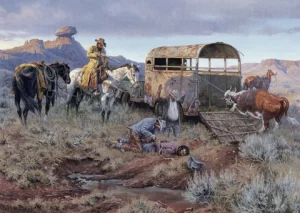 the reality is that not every rustler was from Mexico. The United States had its share of thieves too. One prime target was unbranded new calves. When ranchers failed to brand new calves, it facilitated theft. Unbranded calves were very hard to track, and their theft was difficult to prove. Of course, cattle could be stolen out of necessity, or by the Indians, but while that is technically rustling, it could be looked at somewhat differently. Not that it really ever was. Cattle rustling was cattle rustling, and that was all there was to it.
the reality is that not every rustler was from Mexico. The United States had its share of thieves too. One prime target was unbranded new calves. When ranchers failed to brand new calves, it facilitated theft. Unbranded calves were very hard to track, and their theft was difficult to prove. Of course, cattle could be stolen out of necessity, or by the Indians, but while that is technically rustling, it could be looked at somewhat differently. Not that it really ever was. Cattle rustling was cattle rustling, and that was all there was to it.
Conflict over alleged rustling was a major issue in the Johnson County War of 1892 in Wyoming. The conflict began when cattle companies began persecuting alleged rustlers in the area, many of whom were settlers who competed with them for livestock, land, and water rights. As the violence swelled between the large established ranchers and the smaller settlers in the state, it culminated in the Powder River Country, when the ranchers decided to hire gunmen to invade the county. This was the beginning of vigilantes when it came to cattle rustling. They were ruthless, and they spared no one who was thought to be a rustler.
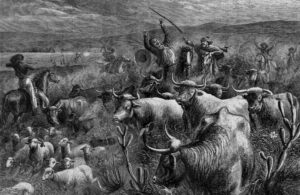
When the ranchers transitioned from open range to fenced grazing, cattle rustling gradually declined in North America. In the 20th century, A different kind of rustling emerged…often called suburban rustling, the practice involved rustlers anesthetizing the cattle and then taking them directly to auction. This eliminated the need to storing the cattle. The practice usually takes place at night, which makes detection difficult for law enforcement. On large ranches, it can take several days for the loss of cattle to be noticed and reported. for that reason, convictions are extremely rare, and even nonexistent.

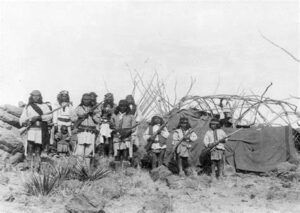 The Indians, at least the ones present in the early days of the United States, were very superstitious, and they believed that the hissing and thundering of the geysers to be voices of evil spirits. Not knowing much about the curvature of the Earth, they also regarded the mountains at the head of the river as the crest of the world. They believed that if they could make it over the summits, they would gain the happy hunting-grounds below. They believed their homes would be blessed. The Indians loved this land and felt like it was the land left to them by their fathers, who had hunted there. They didn’t want to hand it over to the white man. Nevertheless, the soldiers were duty bound to pursue the defiant warriors, to avenge the wrongs the Indians had committed while suffering under the sting of tyranny and wrong. It had been a bloody battle and just scant few of the fugitive band finally gathered at the head of the canyon known as the Grand Canyon of the Yellowstone. These few had succeeded in escaping the bullets of the soldiers, and they had courageously decided to die rather than be taken and carried away to be placed in a distant prison. This was their homeland, and they would die rather than leave it again.
The Indians, at least the ones present in the early days of the United States, were very superstitious, and they believed that the hissing and thundering of the geysers to be voices of evil spirits. Not knowing much about the curvature of the Earth, they also regarded the mountains at the head of the river as the crest of the world. They believed that if they could make it over the summits, they would gain the happy hunting-grounds below. They believed their homes would be blessed. The Indians loved this land and felt like it was the land left to them by their fathers, who had hunted there. They didn’t want to hand it over to the white man. Nevertheless, the soldiers were duty bound to pursue the defiant warriors, to avenge the wrongs the Indians had committed while suffering under the sting of tyranny and wrong. It had been a bloody battle and just scant few of the fugitive band finally gathered at the head of the canyon known as the Grand Canyon of the Yellowstone. These few had succeeded in escaping the bullets of the soldiers, and they had courageously decided to die rather than be taken and carried away to be placed in a distant prison. This was their homeland, and they would die rather than leave it again.
The brave warriors built a raft and tied it securely on the river at the foot of the upper falls. Then they reveled, for a few days, in the peace and the bounty of the area that had always belonged to them, feeling once again that it belonged to them and that maybe there was no such thing as the white men who were pursuing them relentlessly. Their time in that beautiful place was, however, short-lived, and one morning, they are aroused from peaceful sleep by the crack of rifles fire. The soldiers had found them.
With resolve, and knowing that they could not escape, the warriors boarded their raft and pushed out toward the middle of the stream. I don’t know if they were trying for the opposite shore, or if they knew what would happen next, but the current immediately grabbed the raft and held it firmly in its grasp. Some of the warriors had guns that they defiantly discharged at the soldiers. For their part, the soldiers just stood in shock as the scene unfolded in front of their horrified eyes. The soldiers didn’t even fire a single shot, but instead, watched with nothing short of dread as the raft passed into the current and was wildly tossed around, whirling faster and faster. The waves seemed to sing a “death song” as they triumphantly forced the raft closer and closer to the edge and the roar of the falls. It is hard to say if the warriors felt and fear, or if they had simply decided that death was preferred to a life in prison. Whatever they felt, was drowned as the faced the soldiers with a look of defiance, and screamed the tones of the death chant, of no less than hate and even celebration, lurched onward to their end.
In times of war, the two sides are prepared to kill, but as the raft raced toward the edge, the soldiers, as 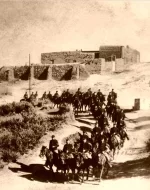
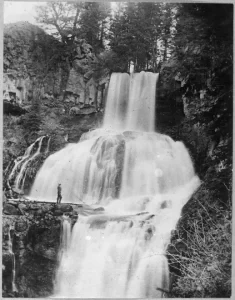 hardened as they were, could not stop their shudders as they contemplated the fate the Indians had chosen for themselves. Then, the brink was reached. The raft was pulled between the jaws of the rocks at the top of the falls. Beyond the rocks were vast walls, leading to the floor of the gulf a thousand feet below. The raft tipped toward the gulf, and with a cry of triumph, the Indians were launched over the edge into the raging falls. As the warriors fell, they were met by the brilliant colors of the rising sun. The view would have normally been considered beautiful and even peaceful, except for the horror of what was coming. Nevertheless, the warriors had decided that they would rather die than leave the land they loved, and so they died…on their own terms.
hardened as they were, could not stop their shudders as they contemplated the fate the Indians had chosen for themselves. Then, the brink was reached. The raft was pulled between the jaws of the rocks at the top of the falls. Beyond the rocks were vast walls, leading to the floor of the gulf a thousand feet below. The raft tipped toward the gulf, and with a cry of triumph, the Indians were launched over the edge into the raging falls. As the warriors fell, they were met by the brilliant colors of the rising sun. The view would have normally been considered beautiful and even peaceful, except for the horror of what was coming. Nevertheless, the warriors had decided that they would rather die than leave the land they loved, and so they died…on their own terms.
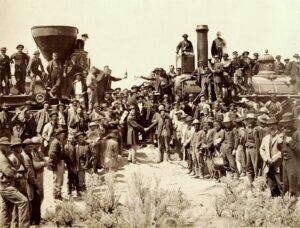 I have taken a number of train rides in my life. I love riding the trains. Some rides were very comfortable, while others are more primitive, with wooden seats, that would not be suitable for a long trip. The transcontinental train was not technically a part of the Gilded Age, when everything was luxurious, but it did feature many of the trapping of that era, and not just in the parlors of the Gilded Age magnates, but in the cars where the everyday travelers would ride too…at least in the first class cars. The cars were adorned with velvet seat cushions and gilt-framed mirrors, and the passengers feasted on antelope, trout, berries, and even champagne. Of course, not every train in 1869 was so elaborately adorned, but then the others were not the Transcontinental Train either. Still, the second-class passengers did have upholstered seats, making their trip not too bad. The third-class, or “emigrant” passengers, paid half of what the first-class passengers did, but they had to sit on benches instead of seats and bring their own food.
I have taken a number of train rides in my life. I love riding the trains. Some rides were very comfortable, while others are more primitive, with wooden seats, that would not be suitable for a long trip. The transcontinental train was not technically a part of the Gilded Age, when everything was luxurious, but it did feature many of the trapping of that era, and not just in the parlors of the Gilded Age magnates, but in the cars where the everyday travelers would ride too…at least in the first class cars. The cars were adorned with velvet seat cushions and gilt-framed mirrors, and the passengers feasted on antelope, trout, berries, and even champagne. Of course, not every train in 1869 was so elaborately adorned, but then the others were not the Transcontinental Train either. Still, the second-class passengers did have upholstered seats, making their trip not too bad. The third-class, or “emigrant” passengers, paid half of what the first-class passengers did, but they had to sit on benches instead of seats and bring their own food.
With the move west, thousands of people flocked to the Transcontinental Railroad beginning in 1869. The 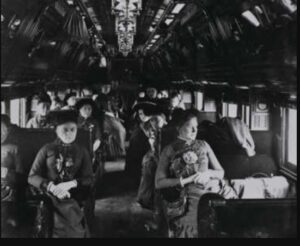 railroad, which stretched nearly 2,000 miles between Iowa, Nebraska, and California, reduced travel time across the West from about six months by wagon or 25 days by stagecoach to just four days. That was an amazing change, and it meant that families that moved west might actually be able to see loved ones they left behind. Prior to that time, moving west could mean saying goodbye forever to the family members who stayed behind. The Transcontinental Railroad represented both the height of modern technology and the tempting possibility of unrestricted travel, although it might take time for people to feel safe with train travel.
railroad, which stretched nearly 2,000 miles between Iowa, Nebraska, and California, reduced travel time across the West from about six months by wagon or 25 days by stagecoach to just four days. That was an amazing change, and it meant that families that moved west might actually be able to see loved ones they left behind. Prior to that time, moving west could mean saying goodbye forever to the family members who stayed behind. The Transcontinental Railroad represented both the height of modern technology and the tempting possibility of unrestricted travel, although it might take time for people to feel safe with train travel.
While the train made it possible to go west much quicker, it wasn’t cheap, nor was it as fast as future forms of travel would be. The first passenger train on the line took 102 hours to travel from Omaha, Nebraska to San Francisco, California, and a first-class ticket cost $134.50, which is about $2,700 today…hardly affordable for a 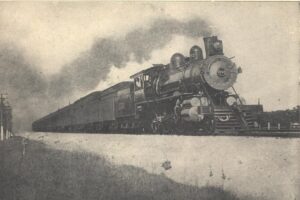 casual trip. Families might save for years to be able to visit their child, and often only one family member could go at a time. The places the train traveled, were not filled with cities, towns, or even very many homesteads, because at the time, the areas through which the train had been built were not yet open to large numbers of white settlers. In fact, millions of acres of the land the new railroad traversed had belonged to the Native American people, but the US Congress had granted the land to railroad companies. The Native Americans saw this as an intrusion, knowing that behind it would come a wave of white settlers. Nevertheless, the trains and the white man were here to stay.
casual trip. Families might save for years to be able to visit their child, and often only one family member could go at a time. The places the train traveled, were not filled with cities, towns, or even very many homesteads, because at the time, the areas through which the train had been built were not yet open to large numbers of white settlers. In fact, millions of acres of the land the new railroad traversed had belonged to the Native American people, but the US Congress had granted the land to railroad companies. The Native Americans saw this as an intrusion, knowing that behind it would come a wave of white settlers. Nevertheless, the trains and the white man were here to stay.

 Recently, in a Mount Saint Helens-esk alert level increase, Mount Spurr, a stratovolcano in the Aleutian Arc of Alaska, made its entrance into the spotlight. The volcano isn’t about to explode in the same way Mount Saint Helens was, but it does appear to be about to erupt again. Mount Spurr was named after United States Geological Survey geologist and explorer Josiah Edward Spurr, who led an expedition to the area in 1898. Mount Spurr is currently rated at a Level of Concern Color Code Yellow by the Alaska Volcano Observatory (AVO). It’s obvious that Mount Spurr has an active history, because it is aboriginally known by the Dena’ina Athabascan name K’idazq’eni, which literally means “that which is burning inside.”
Recently, in a Mount Saint Helens-esk alert level increase, Mount Spurr, a stratovolcano in the Aleutian Arc of Alaska, made its entrance into the spotlight. The volcano isn’t about to explode in the same way Mount Saint Helens was, but it does appear to be about to erupt again. Mount Spurr was named after United States Geological Survey geologist and explorer Josiah Edward Spurr, who led an expedition to the area in 1898. Mount Spurr is currently rated at a Level of Concern Color Code Yellow by the Alaska Volcano Observatory (AVO). It’s obvious that Mount Spurr has an active history, because it is aboriginally known by the Dena’ina Athabascan name K’idazq’eni, which literally means “that which is burning inside.”
Located 81 miles west of Anchorage and northeast of Chakachamna Lake, Mount Spurr is the highest volcano of the Aleutian Arc. It has a large stratocone at the center of a roughly 3.1 miles horseshoe-shaped caldera that is open to the south. The caldera was formed by a Mount Saint Heles like “late-Pleistocene or early Holocene sector collapse and associated pyroclastic flows that destroyed an ancestral Spurr volcano. The debris avalanche traveled more than 15.5 miles to the southeast, and the resulting deposit contains blocks as large as 330 feet in diameter. Several ice-carved post-caldera domes lie in the caldera.” The present-day Mount Spurr is 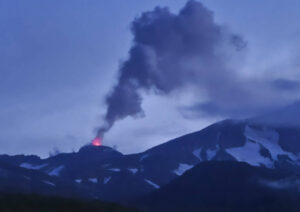 the highest of the post-caldera. So much change can take place as the events of a volcano unfold. The regrown summit peak of Mount Spurr experienced a heating event in 2004 which created a small crater lake. Then, by 2008, the summit crater had cooled enough to have begun to have accumulated significant amounts of snow again. As with any seismically active mountain, the youngest post-caldera dome, Crater Peak has grown to 7,575 feet. “It was formed at the breached southern end of the caldera about 2.0 miles south of Spurr, has been the source of about 40 identified Holocene tephra layers. Spurr’s two historical eruptions, from Crater Peak in 1953 and 1992, deposited ash on the city of Anchorage. Crater Peak has a summit crater that is itself slightly breached along the south rim; the north wall of the crater exposes the truncated remains of an older dome or lava lake. Before the 1992 eruption, a small crater lake occupied the bottom of Crater Peak’s crater.” The problem with volcanoes, especially so close to the major trans-Pacific aviation routes is that an eruption of this volcano can significantly disrupt air travel. Volcanic ash can cause jet engines to fail.
the highest of the post-caldera. So much change can take place as the events of a volcano unfold. The regrown summit peak of Mount Spurr experienced a heating event in 2004 which created a small crater lake. Then, by 2008, the summit crater had cooled enough to have begun to have accumulated significant amounts of snow again. As with any seismically active mountain, the youngest post-caldera dome, Crater Peak has grown to 7,575 feet. “It was formed at the breached southern end of the caldera about 2.0 miles south of Spurr, has been the source of about 40 identified Holocene tephra layers. Spurr’s two historical eruptions, from Crater Peak in 1953 and 1992, deposited ash on the city of Anchorage. Crater Peak has a summit crater that is itself slightly breached along the south rim; the north wall of the crater exposes the truncated remains of an older dome or lava lake. Before the 1992 eruption, a small crater lake occupied the bottom of Crater Peak’s crater.” The problem with volcanoes, especially so close to the major trans-Pacific aviation routes is that an eruption of this volcano can significantly disrupt air travel. Volcanic ash can cause jet engines to fail.
On July 26, 2004, the AVO raised the “Color Concern Code” at Spurr from green to yellow due to an increasing number of earthquakes. When it comes to volcanoes, earthquakes beneath the surface may indicate the movement of magma preceding a volcanic eruption. Of course, the earthquakes might also die out without an eruption. In the first week of August 2004, the AVO reported the presence of a collapse pit, filled with water forming a new crater lake, in the ice and snow cover on the summit. It is thought that this lake might have been caused by an increase in heat flow through the summit lava dome. A debris flow was observed in webcam 
 images, as well as by a nearby pilot on May 3, 2005. A subsequent overflight revealed that much of the sitting pond within the melt hole had drained away, leaving a cauldron of notable depth. On October 23, 2024, the alert level for Mount Spurr was again raised to yellow (advisory), because of an increase in seismic activity, which is what reminds me of the Mount Saint Helens alerts.
images, as well as by a nearby pilot on May 3, 2005. A subsequent overflight revealed that much of the sitting pond within the melt hole had drained away, leaving a cauldron of notable depth. On October 23, 2024, the alert level for Mount Spurr was again raised to yellow (advisory), because of an increase in seismic activity, which is what reminds me of the Mount Saint Helens alerts.
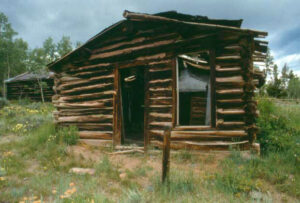
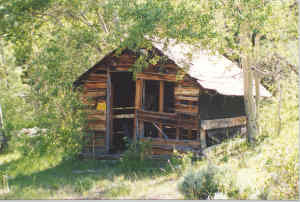 Ghost towns dot the landscape of the United States, including Hamilton City, Wyoming, which is also known as Miner’s Delight. The town is located in Fremont County, on the southeastern tip of the Wind River Range. Miner’s Delight was in a prosperous area during the mining boom in the American West in the second half of the 19th century. It was actually a “sister city” of Atlantic City and South Pass City, however they are more well known and have fared better that Miner’s Delight. Nevertheless, a few buildings still stand today as a reminder of an era in Wyoming’s past history.
Ghost towns dot the landscape of the United States, including Hamilton City, Wyoming, which is also known as Miner’s Delight. The town is located in Fremont County, on the southeastern tip of the Wind River Range. Miner’s Delight was in a prosperous area during the mining boom in the American West in the second half of the 19th century. It was actually a “sister city” of Atlantic City and South Pass City, however they are more well known and have fared better that Miner’s Delight. Nevertheless, a few buildings still stand today as a reminder of an era in Wyoming’s past history.
Like most western mining towns, Miner’s Delight went through several boom-bust periods. With the boom-bust periods came corresponding increases and declines in its population. In 1868, gold was in the area, and by 1870, at the height of the mine’s operations. At that point, the population in Hamilton City was 75, forty of whom were miners. The original boom of mining activity “busted” from 1872 to 1874. Then, by the 1880s a new era of economic prosperity had dawned. There were smaller booms in 1907 and in 1910, and even during the Great Depression. The town was inhabited as late as 1960. By 2015, there were no residents in the town.
Jonathan Pugh founded the Miners Delight mine, which was located about a quarter mile west of the town then known as Hamilton City. The normal boom and bust periods followed, eventually leading to the mine completely shutting down in March 1882. The mine was not used again until after the turn of the 20th century. Then, two brief boom periods in 1907 and in 1910, were in relation to mining operations.
There was one famous incident involving Miner’s Delight which occurred there in March 1893. The incident was widely covered in the press at the time, which was in Cheyenne and was read throughout Wyoming. It came to be known as “the brass lock service mystery.” The postmaster of Miner’s Delight, James “Jimmy” Kime had attempted to ship eight registered letters via the Rawlins and Northwestern’s line’s Lander-to-Rawlins stagecoach to the Postmaster in Rawlins using the “brass lock service.” The Post Office’s “brass lock service” utilized canvas pouches, which were locked with brass locks. The only persons that had a key were the Postmasters along the stage line. When Kime’s pouch reached its destination in Rawlins some 120 miles to the southeast, however, the postmaster there discovered that someone had cut the pouch and stolen all the registered letters. The crime was unheard of
The US Postal inspectors investigated the matter for many months. During that time, a number of other related thefts of various valuables on the line from the locked pouches occurred. Finally, they arrested Postmaster John Gatlin of the Myersville Station near today’s Jeffrey City, Wyoming, along with his wife Stella. The couple was tried in Laramie City and the trial into the Fall of 1893. At that point, charges against John Gatlin were dropped, after Stella Gatlin confessed to stealing the items, due to what she claimed to be her illness of kleptomania. Her affidavit stated that “she had struggled for years to overcome the mania, while keeping it a secret from her husband.” On November 25, 1893, the jury found Mrs. Gatlin guilty. Two days later, she was taken to the Laramie Prison, where she was registered as Prisoner #150, the first woman to be imprisoned there after being convicted of a federal crime in Wyoming. Following a period of “good conduct” she was released early in December 1894, and following her departure, prison officials added a special new wing exclusively for women, with individual cells and a toilet.
Today, the ghost town at Miner’s Delight which eventually went by its nickname, stands as a testament to the 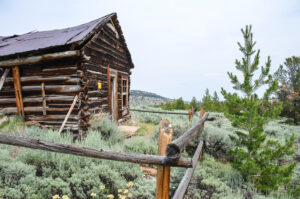
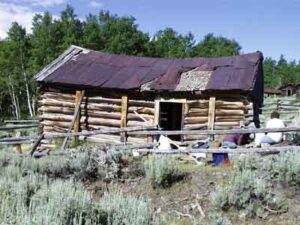 passage of time and provides historians and tourists with a peek at early Wyoming life and the gold mining culture. There are still seventeen structures, including seven cabins, one saloon, one meat house, one shop or barn, one shaft house, one pantry, one cellar, three privies, and a corral on the property. All of the buildings are constructed of logs or unfinished lumber.
passage of time and provides historians and tourists with a peek at early Wyoming life and the gold mining culture. There are still seventeen structures, including seven cabins, one saloon, one meat house, one shop or barn, one shaft house, one pantry, one cellar, three privies, and a corral on the property. All of the buildings are constructed of logs or unfinished lumber.

